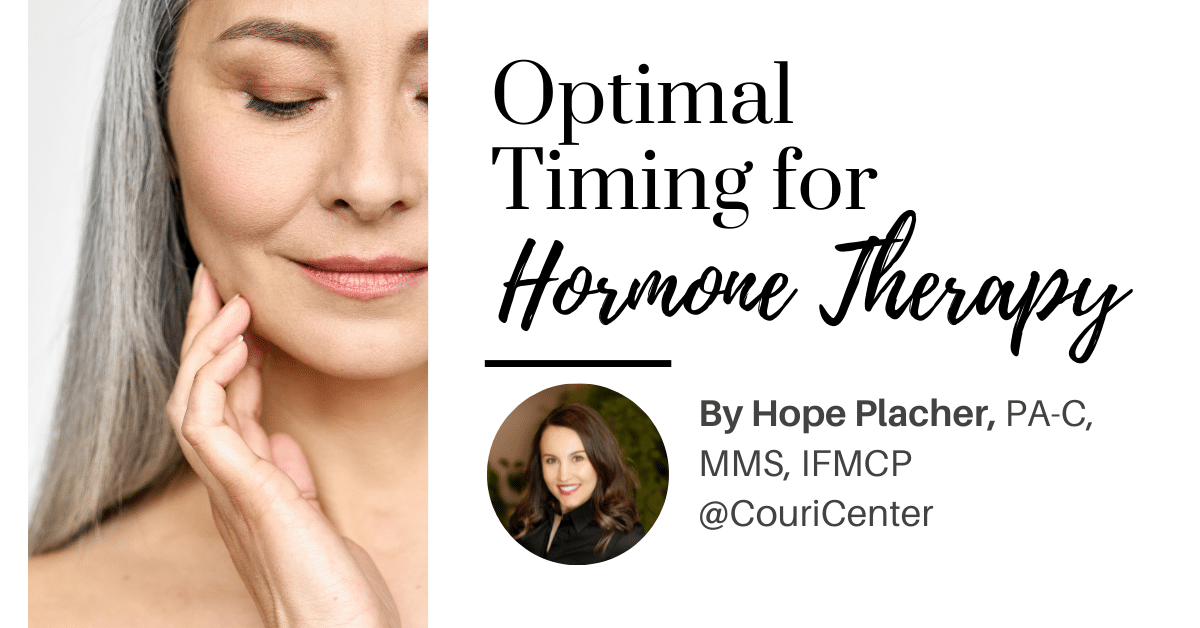
A question that you may have asked yourself if you have ever used bio-identical hormone replacement therapy (BHRT) is when should I start and stop treatment? Classically, women can begin to supplement estrogen, progesterone, or testosterone after they begin to experience symptoms of hormone insufficiency such as infrequent periods, hot flashes, night sweats, fatigue, vaginal dryness, and insomnia (to name a few.) The well-known Women’s Health Initiative (WHI) showed that the fundamental success of HRT is starting hormone therapy within 1-5 years, but no more than 10 years after menopause (after your last menstrual period.) Additional research has shown that the sooner you start replacing the hormones your body is no longer producing, the better. Timing will likely be different for every woman, but consulting with a provider who is well versed in menopause is of the utmost importance. Not every woman is a candidate for hormone replacement, so taking an in-depth medical history will help make this decision.
Are you aware that estradiol replacement is working to alleviate vasomotor symptoms (hot flashes, night sweats, heart palpitations, and changes in blood pressure) and is also a means of protection against cardiovascular disease? It is proposed that one mechanism of estradiol is that it can prevent arterial plaque formation. However, it does not heal or eliminate plaque formed before its initiation.
In March of 2016, the ELITE Research Group published the first randomized control trial to test the hypothesis that the time of initiation of estrogen replacement matters. They found that women who began estradiol replacement < 6 years after menopause had a lower CIMT progression (a measure used to diagnose the extent of carotid artery atherosclerosis, or the ‘age’ of the carotid arteries.) Women who began estradiol replacement > 10 years after menopause did not have an improvement in CIMT.
All of this to say, with a multitude of studies to support that the properly timed initiation of hormone replacement can allow patients to safely receive hormone replacement therapy for extended periods. Published research results of the WHI estrogen therapy trial found that with more than 6 years of estrogen replacement, there was a statistically significant decrease in CVD risk compared with placebo groups! This is ample evidence that closely supervised women taking HRT can safely continue for decades. Also see Dr. Couri’s recent article: 10 Important Facts of Hormone Replacement Therapy. There are medical reasons why a woman may not be a candidate for hormones, and there can also be changes in your health history that may preclude you from staying on hormone therapy. It is essential to schedule annual exams for the duration that you continue hormone therapy. The Couri Center takes great pride in ensuring our patients receive the safest, most effective treatment. Contact us if you have questions regarding your hormone replacement therapy or would like to schedule a visit; we’re here to help.
Hope Placher, PA-C, MMS, IFMCP
RESOURCES:
Hodis HN, Mack WJ, HendersonVW, et al. : Vascular Effects of Early versus Late Postmenopausal Treatment with Estradiol. N Engl J Med. 2016;374(13): 1221-31.
The NAMS 2017 Hormone Therapy Position Statement Advisory Panel: The 2017 hormone therapy position statement of The North American Menopause Society. Menopause. 2017;24(7):728-53.
Langer RD, Simon JA, Langer RD, et al. : Menopause hormone therapy for primary prevention: why the USPSTF is wrong. Menopause. 2017;24(10): 1101-12.
Harman SM, Vittinghoff E, Brinton EA, et al. : Timing and duration of menopausal hormone treatment may affect cardiovascular outcomes. Am J Med. 2011; 124(3):199-205.
